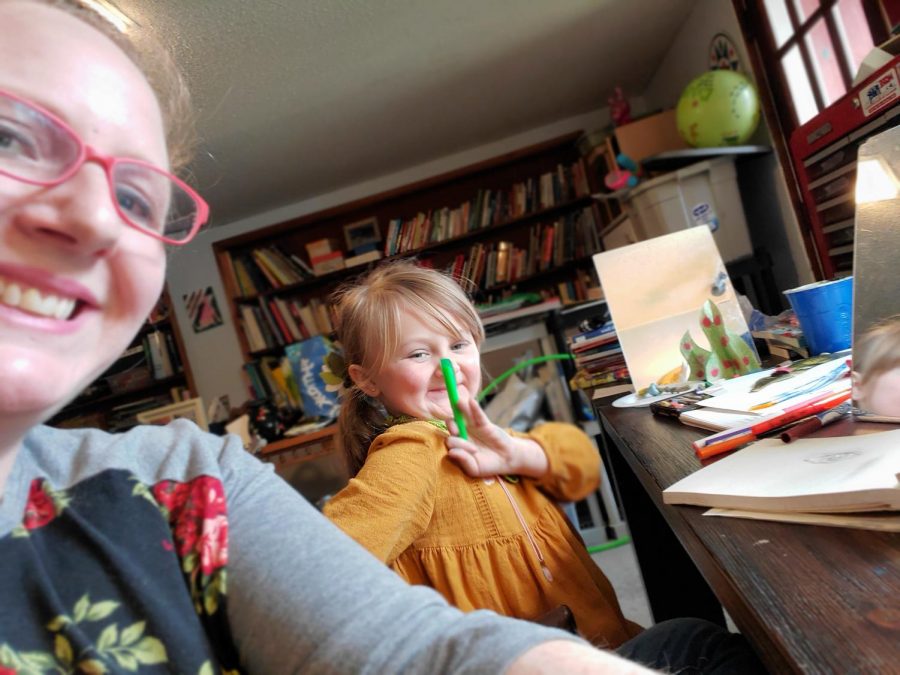Visual arts teachers find inspiration for classes despite online learning obstacles
Art teacher Rebecca Duffy and her child while remote learning from home.
May 21, 2020
Since school closure on March 13, teachers have adjusted to remote learning by utilizing real-time Zoom classes, pre-recorded discussions, online documents, helpful YouTube videos and more. However, even with all of these tools, online classes will never truly replicate the experience of in-person school, especially when it comes to the visual arts.
For example, courses such as Art I, II, and Advanced Art, Photography, Ceramics and Art Gallery & Marketing are hands-on learning classes that involve specific materials and tools that most students only have access to at school.
Art teacher Danielle DeCiero teaches AP Drawing, Ceramics I, II, and Advanced Ceramics along with Art Gallery & Marketing. DeCiero said AP Drawing has been the easiest to replicate because of the students’ at-home access to their sketchbooks and pencils, unlike her ceramics courses.
“Ceramics I, Ceramics II, and Advanced Ceramics have no clay in a class that is designed to refine skills they’ve already learned in Ceramics I with a creative focus,” DeCiero said in an interview via email. “They are losing that entirely, and instead focusing on videos of techniques and planning ideas that may now never get to be implemented.”
DeCiero also struggles with providing beneficial feedback to her visual arts students due to the remote nature of online learning.
“[Feedback] isn’t ’on the spot’ as much during the art-making process,” DeCiero said. “It is usually at the end when someone has submitted, leaving little room for improvement.”
Although she has struggled with not being able to provide feedback for her students, DeCiero says she is still able to be creative with her assignments to keep the classes moving forward.
Photo I, Photo II, AP Art and Digital Art classes are taught by art teacher Michelle Sheppard, but she has many of her classes doing similar course work.
“Right now, my Photo I, Photo II and Digital Art classes are doing a lot of the same projects,” Sheppard said in an email interview. “AP is carrying on with their work, pretty much as normal.”
Although remote learning has brought hurdles to jump through, Sheppard says it has provided students more time to analyze the meaning behind their work.
“For most of those students, [social] distancing has provided them with extra time they can spend thinking about their topics, or even driving around looking for photos,” Sheppard said.
Sheppard has created a project for her Photo and Digital Art students, which she hopes will uplift them in this difficult time away from their friends.
“The thing I’m most excited about is a project I designed for my photo classes, but some Digital Art students are also doing it as well,” Sheppard said. “…Ok, [it’s] a little sappy, but basically, walk to any stream, and the water that flows through it will eventually meet up with the water flowing by your distanced friends.”
The project requires students to visit a nearby stream and capture a picture of the landscape.
Sheppard’s inspiration for this project came from photographer Frank Gohlke, who lived in Southborough and found solace knowing that every small stream in Southborough flowed into the Sudbury Reservoir, and in Northborough, almost every stream flows into the Assabet River.
Art teacher Rebecca Duffy teaches Art I, Art II, Advanced Art II and Sculpture. Although these are entirely hands-on learning environments, Duffy finds it most important to not only be flexible in altering the courses for remote learning but also to be able to think creatively whether it is about instruction, materials, projects or timelines.
“In my interview for my first teaching job ever, the principal of the school asked me ‘Are you flexible?’ ‘Why yes sir, very flexible.’ Then he asked ‘Are you fluid?’” Duffy said in an interview via email. “Those questions have always stuck with me in all of my teaching experience: the idea that even more than being flexible in our curriculum, expectations and interactions, we must be fluid.”
Even though remote learning creates obstacles for her different courses, Duffy has found inspiration through this difficult time to be creative in her assignments.
“As I struggled through the hurdles of Zoom, I relished the connection of seeing my students, of sketching with them in real time,” Duffy said. “I began to craft lessons based on art skill builders, as well as work in art prompts that deal with our very unusual current situation, and I was able to get creative with how we can use what materials we may or may not have at home.”
As the world struggles in a global pandemic, the visual art teachers have been able to provide a distraction from this new reality and create a sense of normalcy for their students in remote learning.
“I am now, for the most part, in the calm rhythm of remote teaching, getting used to the changes that have needed to be implemented, working through adjustments that still need to be made,” Duffy said. “Sometimes I still find myself in the murky depths, but my students are the dragonflies, the frogs and the fish, the lillies on the pads and the sun shining through.”










